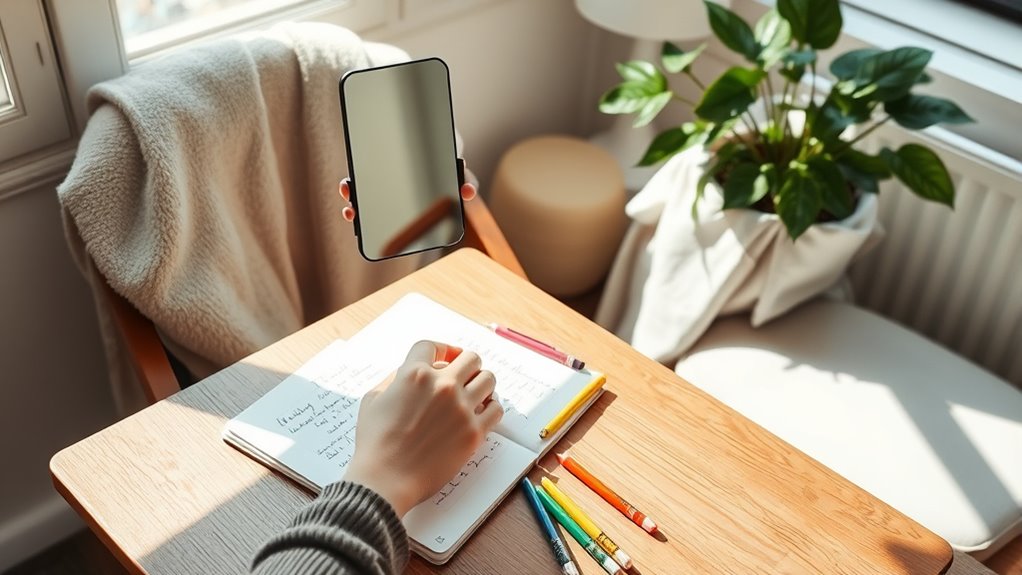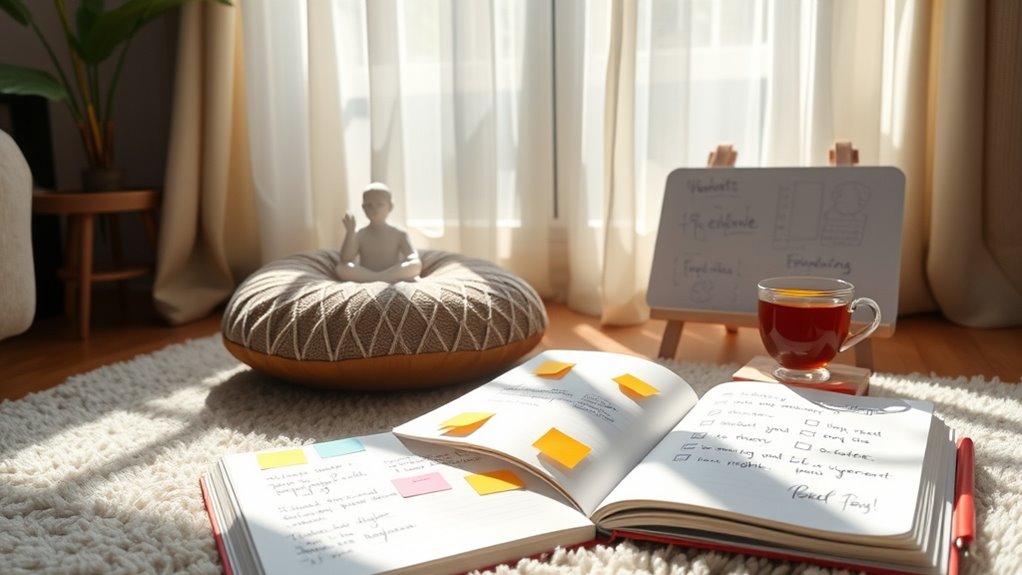To try CBT techniques at home, focus on mindfulness exercises by paying close attention to your breath and daily sensations, which can help you stay present and manage overwhelming feelings. Also, identify automatic negative thoughts and challenge them by questioning their accuracy or reframing them into positive perspectives. Consistently practicing these methods builds emotional resilience and reduces stress. Keep exploring these techniques to develop a healthier mindset and better handle life’s challenges with confidence.
Key Takeaways
- Practice mindfulness exercises to stay present and observe thoughts without judgment, reducing emotional reactivity.
- Identify automatic negative thoughts and evaluate their basis to challenge or reframe them positively.
- Use thought restructuring by questioning evidence and replacing negative beliefs with realistic alternatives.
- Incorporate mindfulness into daily activities like eating or walking to build awareness and emotional regulation.
- Maintain consistency in practicing these techniques to gradually strengthen mental resilience and improve mood.

Have you ever wondered how changing your thoughts can improve your mental health? It’s a powerful idea, and one you can begin to explore through simple techniques like mindfulness exercises and thought restructuring. These methods are core components of cognitive behavioral therapy (CBT) and can be practiced at home to help you manage stress, anxiety, and negative thinking patterns. The key is to become more aware of your thoughts and learn how to challenge or reframe them to promote a healthier mindset.
Mindfulness exercises are a great starting point. They help you stay present and fully aware of your current experience without judgment. For example, you might spend a few minutes each day focusing on your breath, noticing how it feels as you inhale and exhale. As your mind wanders, gently bring your attention back to your breath. This practice cultivates a non-reactive awareness that can reduce feelings of overwhelm and emotional reactivity. You can also incorporate mindfulness into everyday activities, like eating or walking, by paying close attention to each sensation or step. Over time, mindfulness can help you recognize negative thought patterns as they arise, giving you the space to respond more thoughtfully instead of reacting impulsively.
Practicing mindfulness helps you stay present, recognize negative thoughts, and respond thoughtfully instead of reacting impulsively.
Thought restructuring is another effective technique you can try. It involves identifying automatic negative thoughts and challenging their accuracy or helpfulness. When you catch yourself thinking, “I can’t do this,” pause and evaluate whether that thought is based on facts or assumptions. Ask yourself questions like, “What evidence do I have for and against this thought?” or “Is there an alternative explanation?” After evaluating, reframe the thought into a more balanced or positive one, such as, “I’ve faced challenges before, and I can handle this one too.” Practicing thought restructuring regularly helps weaken the grip of negative beliefs and replaces them with realistic, empowering perspectives.
Additionally, understanding how Self Watering Plant Pots work can serve as a metaphor for nurturing your mental health—just as these planters provide consistent moisture to help plants thrive, consistent mental practices can support emotional resilience. Both techniques require consistent effort but can become natural parts of your daily routine. They empower you to take control of your internal dialogue, which directly influences your emotional wellbeing. As you practice, you’ll likely notice a shift in how you interpret stressful situations and a reduction in anxiety or depressive symptoms. Remember, progress might be gradual, but each effort to become more mindful and challenge negative thoughts moves you closer to a more resilient, balanced mental state. With patience and persistence, these techniques can be invaluable tools on your journey to better mental health.
Frequently Asked Questions
Can CBT Techniques Be Used for Children and Teenagers?
You might wonder if CBT techniques work for children and teenagers. The answer is yes, with child-friendly strategies and teen-focused approaches, you can adapt CBT to suit their developmental level. These methods empower young people to recognize and change negative thoughts and behaviors. By using engaging activities and age-appropriate language, you help them build resilience and coping skills, making therapy more effective and accessible for their unique needs.
How Long Does It Take to See Results With CBT at Home?
You might wonder how long it takes to see progress with CBT at home. Usually, with consistent practice and therapy, you’ll notice improvements within a few weeks to a few months. The progress timeline varies for each person, but maintaining therapy consistency is key to achieving results. Stick with the techniques regularly, and you’ll likely start feeling more in control and aware of your thoughts and behaviors over time.
Are There Any Risks or Side Effects of Practicing CBT Techniques?
Back in the day, people wondered if practicing CBT at home might have adverse effects. While generally safe, you could experience emotional discomfort or stress as you confront difficult thoughts. Some might feel overwhelmed or frustrated. These side effects are usually temporary, but it’s wise to stop if you feel overwhelmed and consult a mental health professional. Remember, CBT is a tool, and safety comes first.
Can I Combine CBT With Other Forms of Therapy?
You can definitely combine CBT with other forms of therapy, and many find it beneficial. Integrating therapies, like mindfulness or psychodynamic approaches, can enhance your overall treatment. Complementary approaches often work well together, addressing different aspects of your mental health. Just consult with your therapist beforehand to guarantee the combined methods suit your needs and don’t interfere with each other, creating a more thorough and effective plan.
What Should I Do if I Don’T Notice Improvement?
Like a sailor checking their compass, if you don’t notice progress, don’t lose your way. Keep monitoring your progress closely, and consider trying alternative strategies. Sometimes, the initial approach might not fit, so be open to adjusting your techniques or seeking additional support. Remember, persistence is key, and with steady effort and flexibility, you’ll find what works best for you on your journey to improvement.
Conclusion
As you try these CBT techniques at home, think of your mind as a garden. With each mindful step, you’re planting seeds of positive change, watering them with self-awareness, and pulling out weeds of negative thoughts. Over time, your mental landscape transforms into a flourishing oasis of resilience and clarity. Remember, you’re the gardener of your own mind—tending to it daily, watching it bloom into a healthier, happier version of yourself.









